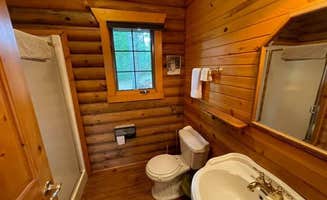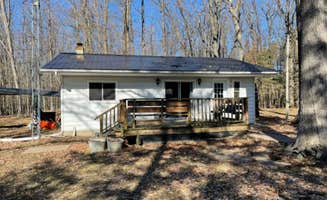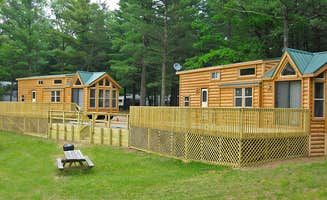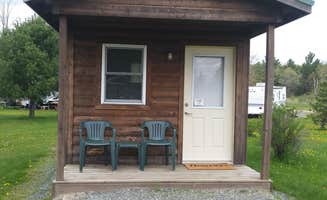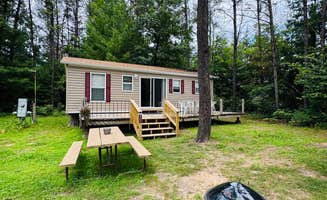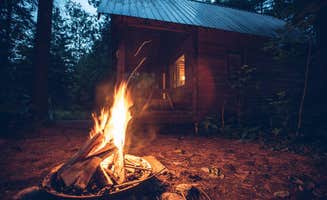Camping cabins near Babcock, Wisconsin sit on the edge of Wisconsin's cranberry country, where sandy soil and ample surface water create ideal conditions for both agriculture and recreation. Located in the Central Sand Plains, the area averages 32 inches of annual precipitation and summer high temperatures around 80°F. Winter cabin rentals face average January lows of 5°F, making weather-resistant accommodations essential during colder months.
What to do
Water recreation on Castle Rock Lake: Buckhorn State Park Campground offers direct water access from many campsites. According to camper Stephanie S., "We got one of the spots that you needed to hike out to but it wasn't far at all... We had a little slice of beach and it was very beautiful during sunset." The lake supports swimming, fishing, and paddle sports.
Fishing opportunities: Multiple species inhabit local waters. A visitor at Buckhorn State Park Campground reports, "The fishing is fantastic with Striped, Largemouth, and Smallmouth Bass, Walleye, Northern Pike, Musky, and all kinds of panfish." Fishing gear is available at some locations.
Mini-golf and recreation: Family-friendly activities abound at cabin camping locations. Pine View Campground features "a minigolf course and a shop and can rent cabins as well. Have kayakes paddleboats and canoes for rent as well. Also have a beach with lifeguard on duty," according to reviewer Rocky M.
What campers like
Beach access: Several cabin locations feature sandy swimming areas. At Vista Royale Campground, "They have a man-made sandy pond with lots of inflatables and kayaks on it. Also a Pavillion and 'octo-ball' court." The main sites provide separation from neighbors with planted pine trees.
Waterpark facilities: Some cabin locations include water recreation beyond natural lakes. According to a visitor at Lakeside Fire Campground & Waterpark, "The park rangers are very kind and extremely helpful. This park is very well maintained with bathrooms and showers that were up kept as well as my own home."
Theme weekends: Scheduled special events enhance the cabin camping experience. At Vista Royale Campground, one camper reports, "We return yearly for trick or treat weekend. We also camp during the summer as well! Had my kids double birthday party here and it was fun!" These organized activities provide structured entertainment options.
What you should know
Insects can be challenging: Ticks and mosquitoes are prevalent, particularly in warmer months. A Buckhorn State Park visitor notes, "The mosquitos here are so tiny they're very easy to miss so look I it for those. Also the mosquitos never let up- even in the rain." Bug spray is essential equipment.
Military presence near some cabins: Pine View Campground - Fort McCoy sits on active military land. According to a reviewer, "North impact area is North of campgrounds. Mortors shooting one evening when we was there. Reveille, call to mess, retreat, tattoo and taps daily."
Highway noise affects some locations: Proximity to major roads impacts certain cabin sites. A review of Oakdale KOA states, "The campground is super easy to get to as it is adjacent to I-90 which means you'll also deal with highway noise. The noise becomes just background after a while."
Tips for camping with families
Look for accommodations with dedicated kid spaces: Several campgrounds feature specialized activities for children. At Pineland Camping Park, "A lot of the activities are designed for 12 and younger. Many of the spots are seasonal."
Consider splash pads for hot weather: Water features enhance summer stays with children. Wisconsin Dells KOA provides "a heated pool with some little attractions attached for the kids," according to one family who adds they "also provided movie night on a project underneath a pavilion."
Pack appropriate bedding: Cabin rentals in the Babcock area typically require guests to bring their own linens. At The Reel Inn RV Campground, cabins offer "Great Place; Central to many key places with very low rates. Clean and Friendly Next to a huge restaurant and bar that have the lowest prices for above average food."
Tips from RVers
Avoid peak season for quiet stays: Weekdays offer more peaceful cabin camping experiences. One RVer notes about Wisconsin Dells KOA, "Busy on weekends quiet and peaceful during the week. Higher prices due to tourist area, but would recommend. Clean laundry room."
Site positioning varies significantly: Some campgrounds offer more privacy between sites than others. At Wisconsin Dells KOA, a visitor reports, "The lots are very small, but overall paved and level so you will have a quick set up. You are on top of your neighbor and your fire pit is close (too close) to all your stuff."
Check gravel conditions for pets: Ground cover affects animal comfort at some locations. A visitor to Pineland Camping Park mentions, "Everything is covered in gravel and stone which is great for parking the camper but not for puppy paws. Had to remove stones 3 times from my poor pups feet."


